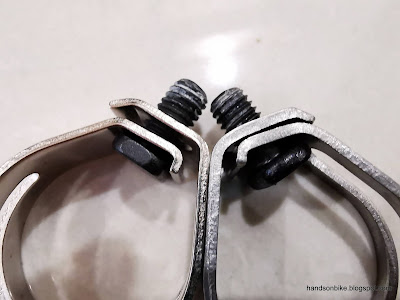It's been a few months since I have completed modifying the United Trifold, but have not had the time to write about the process yet.
When I studied the bike after I received it, I found that there are many features that make it stand out from the other Brompton-style bikes, like Pikes or 3Sixty. Those two brands are basically a direct clone of the Brompton, but this United Trifold is not. The United Trifold is a hybrid of many different folding bikes, which makes it unique, for better or for worse.
Since I was already going to upgrade or change most of the components, I stripped down the bike to the frameset. I was interested to see how heavy the frameset was, as this will dictate how far you can go to achieve a lightweight bike. If the frame is already heavy, it is very difficult and expensive to succeed at building a lightweight bike.
United Trifold with all the components removed.
In the picture shown above, the handlepost is still there only because it holds the fork onto the frame. I will change out the handlepost anyway. The stock seat post is there because it holds the frame together when folded. The rack also remains as it allows the folded frameset to remain standing. Anyway, the rear rack has to be retained to ensure that it can be rolled when folded.
Trifold 7 is the model, as it comes stock with a 7 speed Nexus internal hub. The 2 bottle cage bosses are useful.
Rear rack is mounted to the rear triangle. Made of aluminium, same as the main frame.
I weighed the frame, after removing the fork and rear rack. However, parts that I consider part of the frame is left on the frame, and is included in the frame weight.
In this case, other than the aluminium main frame, the seat post clamp, seat post shim, seat post rubber stopper, and rear triangle hook are included with the frame weight.
The frame weighs 2322 grams, which is an average weight for a frame. In comparison, the Fnhon Tornado frame weighs 2476 grams, which is just a bit more.
Other parts are I did not list above are excluded from the frame weight, as they can be removed and weighed separately. More importantly, those parts are replaceable with good alternatives, which is why I needed to know the stock weight, in case I want to replace them later.
Stock frame clamp is same as the Brompton design. Weighs 66 grams.
The rear hook is considered part of the frame. The design seems to be an exact copy of the Brompton type, and works well.
Stock rear suspension block weighs 71 grams. It is not compatible with the Brompton design.
I feel that the frame weight is slightly heavy, considering that it is made of aluminium, instead of steel like the Brompton. Still acceptable though, unlike the Java Neo 2 which has a really heavy frame weight.
Moving on, I also weighed the front fork. It is not so easy to find a suitable front fork, as the fork rake angle is rather big. Also, there is a mounting point on the side of the fork for the hook, which aftermarket forks don't have. I will use this stock front fork, else I will be replacing almost the entire bike.
The front fork is so heavy! 664 grams, which shocked me.
In comparison, the longer 20 inch aluminium fork on the Fnhon Tornado is 433 grams, whereas the steel fork on the Fnhon Gust is similar at 637 grams.
I expected this aluminium fork of the United Trifold to be much lighter, maybe at 400+ grams. However, it is over 200 grams heavier than expected. Why?
The main reason is that although the fork legs are aluminium, it has a steel steerer tube! This adds a lot of weight to the fork.
Upon removing the handlepost, I also found that the steel steerer tube has a nut welded at the top, for the compression bolt to tighten into. This is badly rusted as you can see below. Since I don't have a good alternative fork, I have to use this no matter what.
Steel steerer tube with a nut welded inside, instead of being threaded like on Dahon forks. Quite shocking to see this level of rust on a new bike.
This gives a total frameset (frame + fork) weight of 2986 grams, which is almost 3 kg. Most aluminium folding bikes are around this range, so it is not too bad. It could have been about 200 grams lighter if an aluminium steerer tube was used on the fork instead.
Finally, let's see some pictures of the folded frameset, before I start installing new components on it.
Folded frameset, without any components on it.
The 4 wheels roll well. Slightly misaligned but OK, unlike the bad ones on the Flamingo.
When folded, the bottom bracket may rest on the chain stay, depending on your tire size.
With the frameset ready, the next step is to install all the new components on it. I have split up the components into many different posts, because there are just so many pictures and info to write about.
This is not a straightforward upgrade, as I am trying many things for the first time. This makes it challenging and yet also exciting, as there is much to learn and improve. Some ideas will fail, and that is OK.





















































